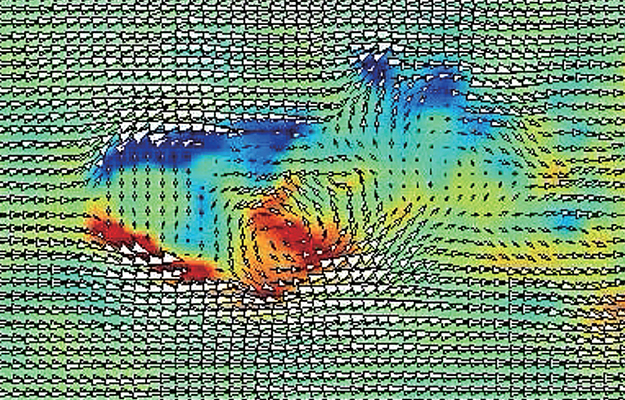Particle Image Velocimetry

PARTICLE IMAGE VELOCIMETRY
Particle Image Velocimetry, otherwise known as PIV, is an optical method widely used in flow visualization and fluid dynamics research. PIV provides detailed measurements of velocities, vectors and related properties in fluids.
The technique is used to obtain the time dependent velocity distributions in a Field-Of-View (FOV) of single and multi-phase flows which are very fast, turbulent and complex. PIV is very useful for analysis of turbulent flow, transient flow, micro flow and 3D volumetric flow studies. As an example, the high temporal rate allows visualization of the laminar separation bubble found in the flow over an airfoil, turbulent flow near an object or complex flows found in bioreactors.
To facilitate visualization of a flow, most applications require seeding the flow with tracer particles. These tracer particles will be very visible in the flow when pulsed with a sheet or spot laser illumination. The laser illumination is very short in duration, easily stopping all motion. When the laser illumination is off, the image is completely dark. The short intense laser pulse provides an excellent contrast to the tracer particles after capture. The tracer particles can then be tracked for movement in the flow where each image is analyzed for the position of these particles as a function of time. Knowing the precise time between the double laser pulse provides a reference for the spacing and direction change between these particles in the image sequence. The particles are plotted as a series of velocity vectors representing the flow at a given instant in time.
For years, high-speed imaging has been utilized in the following industries for PIV research and analysis: Automotive, Aerospace, Biotech and Medical, Marine Propulsion, and Electronics. There are several companies that manufacture high-speed cameras, so how do you decide which company to buy from and which model of camera to buy? There are a couple factors that are important to consider when purchasing a high-speed camera for PIV applications, including frame rate, light sensitivity, resolution, and interframe time.
Phase Image-based Particle Tracking Velocimetry using Digital Holographic Microscopy
Read more
Tomographic Particle-Image Velocimetry Analysis of the Influence of Artificially Introduced Sound Waves on Transonic Buffet Flow
Read more
Hydrodynamic structure of a bubbly flow in an annular channel: experimental study by means of PIV/PFBI/PTV
Read more
